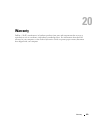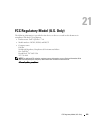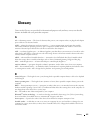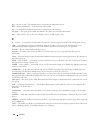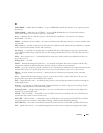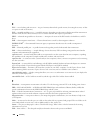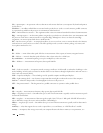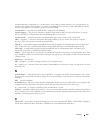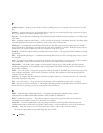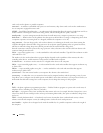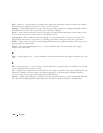
366 Glossary
cards can be used in phones or portable computers.
smart card — A card that is embedded with a processor and a memory chip. Smart cards can be used to authenticate a
user on computers equipped for smart cards.
S/PDIF — Sony/Philips Digital Interface — An audio transfer file format that allows the transfer of audio from one file to
another without converting it to and from an analog format, which could degrade the quality of the file.
standby mode — A power management mode that shuts down all unnecessary computer operations to save energy.
Strike Zone™ — Reinforced area of the platform base that protects the hard drive by acting as a dampening device when
a computer experiences resonating shock or is dropped (whether the computer is on or off).
surge protectors — Prevent voltage spikes, such as those that may occur during an electrical storm, from entering the
computer through the electrical outlet. Surge protectors do not protect against lightning strikes or against brownouts,
which occur when the voltage drops more than 20 percent below the normal AC-line voltage level.
Network connections cannot be protected by surge protectors. Always disconnect the network cable from the network
connector during electrical storms.
SVGA — super-video graphics array — A video standard for video cards and controllers. Typical SVGA resolutions are 800
x 600 and 1024 x 768.
The number of colors and resolution that a program displays depends on the capabilities of the monitor, the video
controller and its drivers, and the amount of video memory installed in the computer.
S-video TV-out — A connector used to attach a TV or digital audio device to the computer.
SXGA — super-extended graphics array — A video standard for video cards and controllers that supports resolutions up
to 1280 x 1024.
SXGA+ — super-extended graphics array plus — A video standard for video cards and controllers that supports
resolutions up to 1400 x 1050.
system board — The main circuit board in your computer. Also known as the motherboard.
system setup — A utility that serves as an interface between the computer hardware and the operating system. System
setup allows you to configure user-selectable options in the BIOS, such as date and time or system password. Unless you
understand what effect the settings have on the computer, do not change the settings for this program.
T
TAPI — telephony application programming interface — Enables Windows programs to operate with a wide variety of
telephony devices, including voice, data, fax, and video.
text editor — A program used to create and edit files that contain only text; for example, Windows Notepad uses a text
editor. Text editors do not usually provide word wrap or formatting functionality (the option to underline, change fonts,
and so on).
TPM — trusted platform module — A hardware-based security feature that when combined with security software
enhances network and computer security by enabling features such as file and e-mail protection.
travel module — A plastic device designed to fit inside the module bay of a portable computer to reduce the weight of
the computer.



